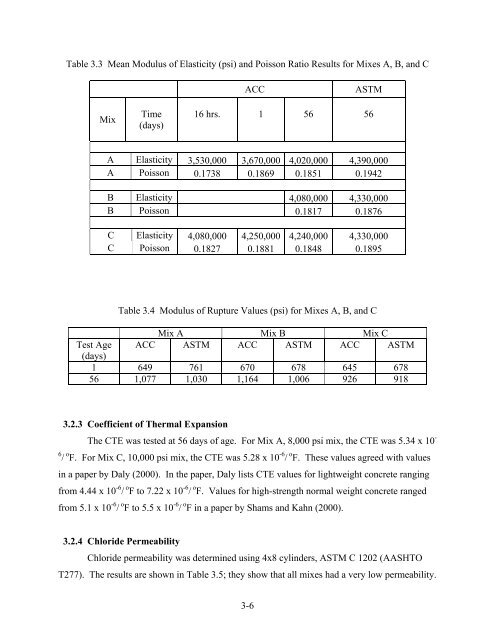Lightweight Concrete for High Strength - Expanded Shale & Clay
Lightweight Concrete for High Strength - Expanded Shale & Clay
Lightweight Concrete for High Strength - Expanded Shale & Clay
Create successful ePaper yourself
Turn your PDF publications into a flip-book with our unique Google optimized e-Paper software.
Table 3.3 Mean Modulus of Elasticity (psi) and Poisson Ratio Results <strong>for</strong> Mixes A, B, and C<br />
ACC<br />
ASTM<br />
Mix<br />
Time<br />
(days)<br />
16 hrs. 1 56 56<br />
A Elasticity 3,530,000 3,670,000 4,020,000 4,390,000<br />
A Poisson 0.1738 0.1869 0.1851 0.1942<br />
B Elasticity 4,080,000 4,330,000<br />
B Poisson 0.1817 0.1876<br />
C Elasticity 4,080,000 4,250,000 4,240,000 4,330,000<br />
C Poisson 0.1827 0.1881 0.1848 0.1895<br />
Test Age<br />
(days)<br />
Table 3.4 Modulus of Rupture Values (psi) <strong>for</strong> Mixes A, B, and C<br />
Mix A Mix B Mix C<br />
ACC ASTM ACC ASTM ACC ASTM<br />
1 649 761 670 678 645 678<br />
56 1,077 1,030 1,164 1,006 926 918<br />
3.2.3 Coefficient of Thermal Expansion<br />
The CTE was tested at 56 days of age. For Mix A, 8,000 psi mix, the CTE was 5.34 x 10 -<br />
6 / o F. For Mix C, 10,000 psi mix, the CTE was 5.28 x 10 -6 / o F. These values agreed with values<br />
in a paper by Daly (2000). In the paper, Daly lists CTE values <strong>for</strong> lightweight concrete ranging<br />
from 4.44 x 10 -6 / o F to 7.22 x 10 -6 / o F. Values <strong>for</strong> high-strength normal weight concrete ranged<br />
from 5.1 x 10 -6 / o F to 5.5 x 10 -6 / o F in a paper by Shams and Kahn (2000).<br />
3.2.4 Chloride Permeability<br />
Chloride permeability was determined using 4x8 cylinders, ASTM C 1202 (AASHTO<br />
T277). The results are shown in Table 3.5; they show that all mixes had a very low permeability.<br />
3-6















